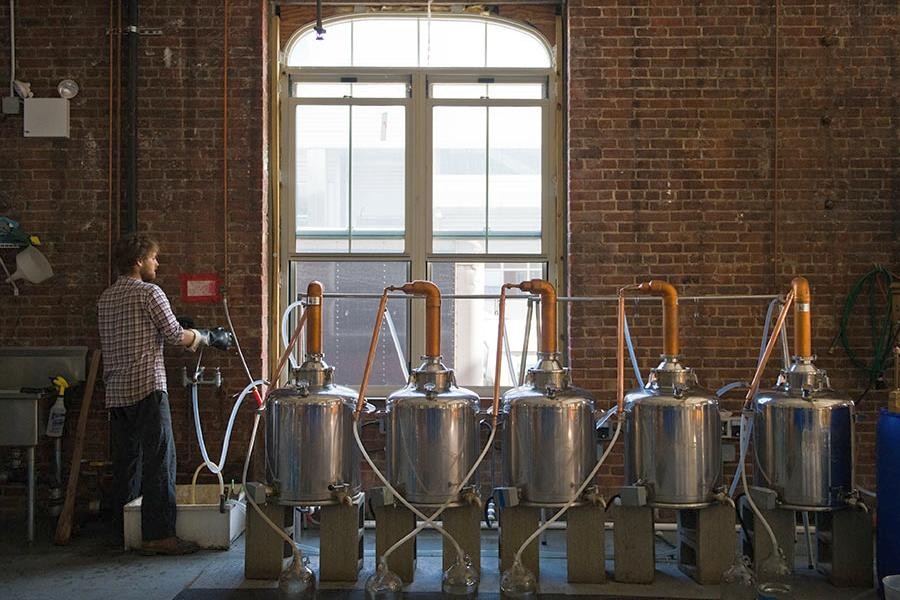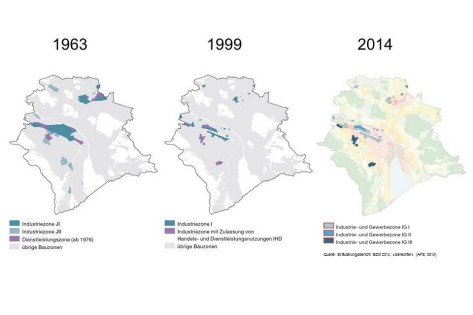Urban production for a diverse city
August 16, 2017 - Günther Arber
After the decline of industry and manufacturing in the course of structural change, relocation and displacement, efforts are now being made in various western cities to keep and settle companies in the workplace. This is also the case in the city of Zurich, where the areas for this have been secured in terms of planning and a strategic focus is underway. What is behind the commitment to urban production and what are the challenges?
The importance of the public-oriented industry – i.e. shops, district-related services and gastronomy – for a diverse and attractive city is undisputed. But what have manufacturing and industry lost in the western city today? As early as 1992, during the consultations of the revised Building and Zoning Regulations (BZO), the city of Zurich debated whether areas for production companies should not be made obsolete and whether the industrial and commercial zone should therefore be opened "immediately and unconditionally" for financially strong services.
Securing space
This has not happened, as a look at the partially revised Building and Zoning Regulations (BZO 2014) adopted by the Zurich Municipal Council in October 2016 show. While the area allocated to the industrial and commercial zone has been successively reduced since the BZO in 1963 with each revision until the BZO in 1999 and at the same time partially opened for the settlement of pure service companies, the wind has turned with the BZO 2014.
The areas in the industrial and commercial zone are currently the same as in 1999 and account for around five percent of the building zone area in the city of Zurich. To this end, with the latest BZO revision, the proportion of possible service areas in some areas was again restricted compared to the BZO in 1999. Thus, the strategic goal formulated in principle by the Zurich city government in 2007 and spatially concretized in 2010 to preserve the locations for industry and commerce has found its legally binding expression. This is not a matter of course in view of the housing shortage and pressure to exploit as well as the fact that much of what used to make up the local workplace and has disappeared will not come back.
Production in the city
Behind this securing of land in Zurich and similar efforts elsewhere is the return to the city as a location for the production and processing of goods, which has been observed for some time. In the search for new uses for the brownfield sites created by the deindustrialization towards the end of the 20th century, production was of course hardly an issue at first. Only social and technological changes, which on the one hand brought the cities back into play as an attractive living space and on the other hand enabled a less disturbing, small-scale and innovative – "urban" – production, changed this. The potential of urban production for a diverse, lively city of short distances with a diversified economy and a wide range of jobs became obvious, the topic found its way into urban development. This revival of production in the city is made possible and driven by three factors: firstly, through digitization with new manufacturing methods and processes, secondly, by the demand for high-quality and sustainable products in the big cities, and thirdly by the specialized workforce and networks of mostly small companies that can manage the development, processing and marketing of these goods.
Today, urban production is an issue in various major Western cities. For example, in Stuttgart, where the city is intensively dealing with new production methods and conditions and the spatial consequences against the background of its still strong industrial character. Another example is Berlin. Here, a broad-based technology foundation investigates and promotes urban production and the city is currently working intensively on the topic in the further development of its urban development plan for industry and commerce . Urban production – often referred to here as "urban manufacturing" – is also on the agenda on the other side of the Atlantic. This is impressively demonstrated by New York City, where the city has been protecting and supporting manufacturing and industry since 2005. In this context, the city is developing the Brooklyn Navy Yard , which was acquired by the Navy between the sought-after residential districts of Dumbo and Williamsburg, into a 120-hectare hotspot for urban production.

Another example is San Francisco. Since 2010, a private initiative supported by the city has managed to establish "SFMade", a brand for the diverse urban production in the Pacific metropolis.
Reclaimed land
In practice, the planning and licensing offices are probably faced with tricky questions when dealing with urban production, not only in the city of Zurich. The use planning of zones for commercial-industrial activities once took place in order to protect the urban residential areas from immissions. Today, this zone purpose is usually incidental, as many urban production companies could also be in mixed zones due to their less disturbing character. There, however, with a high demand for space, the protection against the more solvent uses of housing and services is not available. That is why the remaining areas in the industrial and commercial zones today have an important function as "price islands" for urban production companies. However, the definition of production plants and thus their approval in the industrial and commercial zones is increasingly causing difficulties.
In the city of Zurich, companies must be effectively producing on at least 55% of their area in order to be approved as production facilities in these zones. In the course of the change in the commercial-industrial world of work, which is driven in particular by digitization, however, once clearly distinguishable operating functions such as production, IT, training or showrooms are becoming increasingly blurred and are questioning such once expedient rules. Many modern production plants do not fit more or less and less "into the conventional categories of the economy. Nor do the places needed for this mix of technology, research, production and distribution fit into our traditional image of an industry with smoking chimneys and noisy machines»*. Today, the urban workplace is difficult to grasp and ranges from companies in the rather classic manufacturing industry to high-tech companies and creative industries. The space requirements, location requirements and payment options are correspondingly diverse.
How to deal with such challenges varies from city to city due to different legal framework conditions. One thing is certain: where the exclusion of more solvent uses through planning and building law provisions does not ensure suitable and affordable areas for urban production, only ownership can do so with a voluntary renunciation of possible yields. Here, as in sovereign land use planning, cities play an important role in enabling urban production: "Local governments must preserve manufacturing space"**.
In the city of Zurich, a strategy focus under the leadership of the Urban Development Department deals with the future of the urban workplace. The most important spatial concretization at present is the transformation of the four-hectare "Werkstadt" area of the Swiss Federal Railways , which was once used for railway operations, into an attractive area for contemporary urban production. Such a development project is new for Zurich and a challenge for those involved. Here it is necessary to find answers to a variety of economic, operational, legal, planning and design questions in connection with urban production.
More information
Industry and Maker Movement at the Brooklyn Navy Yard. Author: Kaja Kühl. In: Werk, Bau+Wohnen 4/2016, Projekt Arbeit, pp. 44-50 (* quote p. 50).
Production in the city. Author: Anne-Caroline Erbstösser. Technologiestiftung Berlin, 2016.
The future of manufacturing in cities. Author: Adam Friedman. In: City as loft: Adaptive reuse as a resource for sustainable urban development. Editors: Martina Baum and Kees Christiaanse. Zurich, 2012. pp. 332-337 (** quote p. 337).
Vertical urban factory. Author: Nina Rappaport. New York, 2015.
How the new production is changing urban development – Take Stuttgart as an example. Authors: Frank Gwildis and Stefan Werrer. In: Stadt Bauwelt 35.2016, Die Produktive Stadt, pp. 34-37.
